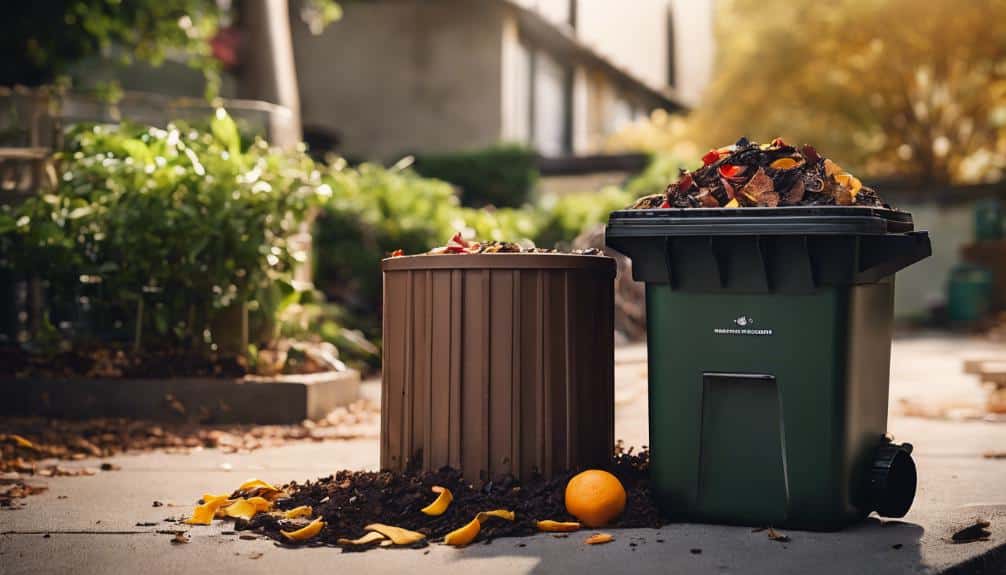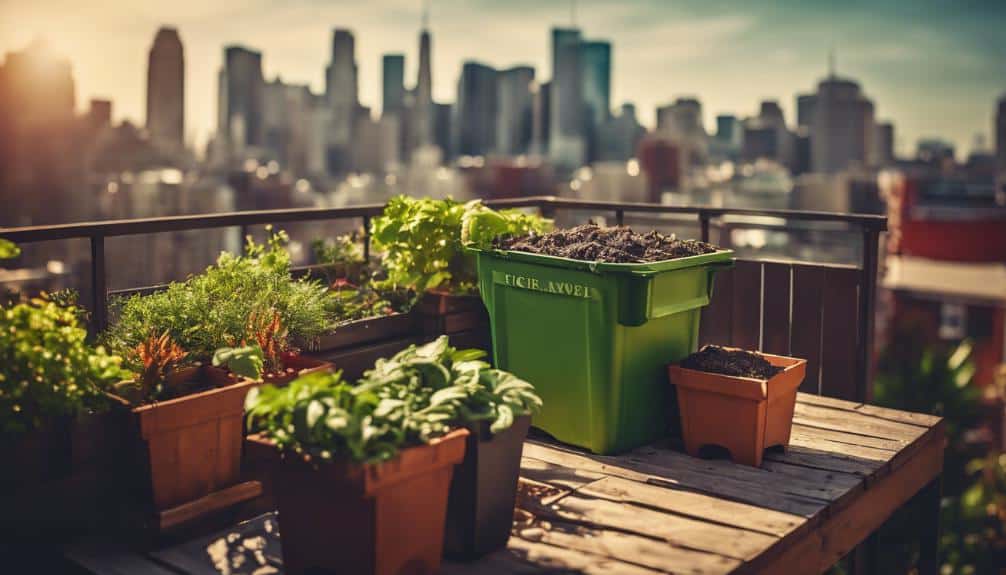Creating a compost bin for your urban garden is easy. Use wood or recycled plastic for good air circulation. Place the bin near your garden but not too close to your home.
Compost fruit and veggie scraps, coffee grounds, and eggshells, but avoid meat and dairy. Turn your compost regularly to keep it healthy and odor-free.
Have a small space? Don’t worry you can try vertical gardening in your urban garden. And container gardening on your balcony is also a good idea. Or grow vegetables that don’t requre much space to grow.
Best Materials for Urban Compost Bins

Durable, Breathable Bins for Urban Composting
When composting in an urban setting with limited space, it’s important to choose a bin made from durable yet breathable materials.
Wood and recycled plastic are excellent options that allow proper airflow while withstanding outdoor conditions over many composting cycles.
Avoid solid plastic bins that can restrict airflow and cause anaerobic conditions. The bin should have adjustable air vents or slats to regulate oxygen exposure as needed.
Air Circulating Materials Promote Compost Decomposition
Ensuring good air circulation is crucial for efficient aerobic decomposition of organic materials in your compost bin.
Opt for bin materials and designs that maximize air exposure, such as slatted wood, mesh sides, or specially designed aeration channels.
The increased oxygen allows beneficial aerobic bacteria to thrive, breaking down materials more quickly into nutrient-rich compost. Without airflow, anaerobic conditions take over, causing foul odors.
Design for Easy Compost Addition/Removal
Look for a compost bin designed with convenience in mind to make your routine easier. An opening or removable top section allows you to easily add new kitchen scraps and yard waste regularly.
And a front-opening door, removable slats, or a tumbler design enables simple removal of your finished compost when it’s ready to be added to garden beds.
Awkward lifting and straining will discourage consistent maintenance.
DIY Bins Fit Space and Needs
If premade compost bins don’t suit your needs, consider building your own DIY version.
This allows you to fully customize the size to fit your available space and match your composting volume. Adapt the design with specific features like dual chambers, removable fronts, lids, or aeration tools.
DIY gives you flexibility while reducing costs. Reclaimed wood and repurposed materials make great low-cost options.
Climate-Appropriate Bin Materials Prevent Drying/Soaking
Different climates present different challenges for compost bins.
In hot, dry regions prioritize a thick, insulated, shaded design to prevent your compost from drying out too quickly.
In damp, rainy areas, adequate drainage and airflow become paramount to stop saturation and anaerobic conditions.
Adapt your bin material choices, whether more moisture-wicking like wood or water-resistant like plastic, to your local environment.
Wooden Bins Insulate, Look Nice Naturally
Wooden compost bins offer both effective insulation to aid in maintaining ideal heat levels, as well as a natural, attractive appearance that blends nicely into a garden setting.
Be sure to use untreated, chemical-free wood to avoid contaminating your compost. Wood allows good airflow while protecting the compost from temperature swings. The natural materials also visually complement most outdoor spaces.
Recycled Plastic Bins: Light, Clean, Rot-Resistant
For an urban bin that is low-maintenance and long-lasting, recycled plastic is an excellent choice.
These bins tend to be lightweight yet highly durable, easily moved as needed. The non-porous plastic resists moisture and rotting year after year.
Plastic is simple to hose off for cleaning when swapping batches. And many recycled models have design features like sliding doors, drainage ports, and locking lids for convenience.
Space Requirements for Urban Compost Bins
Garden Size Impacts Ideal Compost Bin Space
The size of your garden will dictate how much composted material you need and the ideal bin capacity. A large vegetable garden requires more compost than a few flower beds.
Assess your garden’s total square footage and plant density to determine if you need a larger or smaller compost bin.
Too small and you’ll run out of compost. Too large and you’ll struggle to fill and maintain the bin.
Place Bin Near Garden, Away From House
For convenience, place your compost bin in close proximity to your garden beds.
This makes it easy to add fresh materials and retrieve finished compost.
However, be sure to position the bin a reasonable distance from your house. As compost breaks down, it can produce odors that may be unpleasant if too close to doors or windows.
Creative Bin Design for Limited Garden Spaces
If you have a small yard or just a patio, get creative with compost bin design.
Look for compact bins that can tuck into tight spaces. Vertical towers, stacked rings, and folding bins make efficient use of limited space.
Some people even build underground digesters or convert old trash cans into tumblers.
Optimize Compost Access and Turning Space Efficiency
Whichever bin you choose, ensure you can easily access it to add new materials and turn the composting materials regularly.
Leave enough space around the bin for a pitchfork and room to move.
Strategically positioning lids or openings at an ideal height prevents excessive bending.
Small Bin for Kitchen and Yard Waste
If your compost needs are modest, such as just handling kitchen vegetable scraps and light yard waste, a small stationary or tumbling bin may be perfect.
These space-saving models have enough capacity for a household’s compostable output without requiring too much maintenance.
Vertical/Multi-Compartment Bins Save Garden Space
Vertical stackable bins and multi-compartment designed are very space efficient compost solutions. Multiple chambers allow you to start new batches before emptying finished compost.
Upright designs have a small footprint ideal for compact yards. Look for models with removable doors to easily access each level.
Match Bin Size to Waste Volume Generated
The ideal compost bin size corresponds to the volume of organic waste you generate.
A large household with a productive garden may need a bigger bin than a smaller house with limited plant debris.
Consider getting a larger model than you think you need to avoid frequently emptying it. Leaving extra air space also aids decomposition.
Appropriately Sized Compost Bin Enhances Garden Health
By carefully choosing the right size compost bin for your needs, you can consistently provide your garden with a nutritious supply of decomposed material.
An oversized bin is difficult to fill and maintain, while an undersized one can’t handle all your compostable waste. The Goldilocks solution produces just the right amount of compost to feed your plants.
What can and cannot be composted in an urban setting?

- In urban settings, you can compost fruit and vegetable scraps, coffee grounds, tea bags, eggshells, and plant trimmings indoors.
- Avoid composting meat, dairy, and oily foods indoors to prevent odors and pests.
- Community composting programs may accept a wider range of materials, including meat and dairy products.
- Check local guidelines for community composting to know what materials are accepted.
Maintaining and Turning Urban Compost Piles
Turn and Aerate Compost Pile Regularly
Regularly turning and aerating your compost pile introduces oxygen and promotes even decomposition.
Use a pitchfork or aerator tool to mix the materials and prevent compaction. This helps maintain an active pile and discourages foul odors from anaerobic conditions.
Aim to turn the pile every 1-2 weeks.
Mix Outer/Inner for Even Decomposition
When turning your compost, make sure to blend the outer cooler layers with the inner hotter sections.
The microbes in the hotter core areas break materials down quickly, while the cooler outer edges decompose slowly. Mixing distributes oxygen and microbes evenly for consistent, efficient composting.
Temperature Monitoring Crucial for Healthy Compost
An ideal compost pile should generate heat as materials break down through microbial action.
Monitoring the temperature helps ensure the pile is actively composting.
Use a compost thermometer and aim for 130-160°F at the center. Cool temperatures signal insufficient decomposition.
Compost Should Warm Up During Breakdown
As organic materials like food scraps and yard waste decompose, they generate heat through microbial metabolism.
A properly balanced compost pile will warm up significantly, especially at the core, as an indicator that safe, efficient composting is occurring.
Adjust Moisture for Wrung Sponge Texture
Maintaining proper moisture is key for optimal compost breakdown.
The pile should be damp but not soaked, with a wrung sponge texture.
Add dry brown materials like leaves if too wet, or water gently if too dry. Proper drainage also prevents oversaturation.
Aerate by Turning or Aerator Tool
Introducing air into the compost pile provides oxygen for aerobic microbes that facilitate faster decomposition.
Turn and fluff the pile regularly with a pitchfork or use an aeration tool designed to inject air without disrupting layers. Avoiding compaction aids airflow.
Preventing Odors from Urban Compost Bins

Layer green (nitrogen-rich) and brown (carbon-rich) materials to maintain a balanced carbon-nitrogen ratio and reduce odors.
Keep your compost bin covered with an airtight lid to prevent pests and control smells.
Maintain moisture levels in your compost bin with a good lid to help control odors.
Frequently Asked Questions
Can Compost Bins Attract Pests or Rodents?
Yes, compost bins can attract pests or rodents, but you can avoid this by using rodent-proof designs, implementing pest management strategies, and managing organic odor control to keep your compost bin unattractive to unwanted visitors.
How Long Does It Take for Compost to Be Ready?
You’ll find your compost ready in 3 to 6 months. It depends on the compost ingredients, turning frequency, and moisture levels. Regularly turning and maintaining the right moisture speeds up the decomposition process.
Is It Necessary to Add Worms to My Compost Bin?
You don’t have to add worms, but doing so can boost your compost’s quality. Worm species selection is essential for nutrient acceleration. Vermicomposting benefits include faster decomposition and richer compost, enhancing your garden’s productivity.
Can Composting Be Done Indoors in Small Apartments?
Yes, you can compost indoors in small apartments by focusing on indoor ventilation, space-saving designs, and odor management. These key factors guarantee your composting is effective without taking up too much space or causing unpleasant smells.
How Does Weather Affect Urban Composting?
Weather impacts your composting efforts through temperature control, moisture management, and seasonal adjustments. You’ll need to keep it warm enough in cold months and manage moisture levels, especially during rainy or dry seasons.
